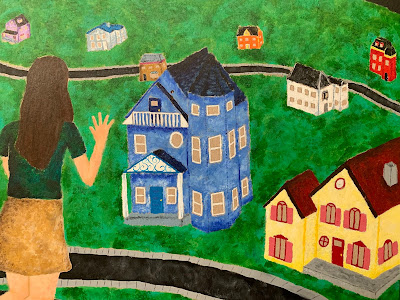At the end of my junior year, I met my future art teacher. Yes, I had been at that school since I was an actual three-year-old, and I had barely stepped foot in the art room. All my fine arts elective credits came from orchestra and creative writing, so I never needed to take any additional credits. Besides, I never saw myself as an artist. I could draw manatees and buildings. That’s it.
However, through a series of unusual events that I can’t quite remember, I ended up in the art wing office, pointing to a college poster on her wall and saying, “Hey, I’m applying there!”
“How haven’t I met you yet?” she said.
From there, we got to talking about how I want to go into architecture. I explained how I’d done a summer course the previous summer and had fallen in love with it. I knew exactly what I wanted to do, and I couldn’t wait.
Then she recommended me for AP Studio Art.
It was vital that I familiarize myself with the studio setting, she told me, and art skills would be beneficial in a design program. Even though I had never taken an art class before, and therefore could barely hold a paintbrush, I would probably be okay.
Spoiler alert: I wasn’t.
The other six girls in my class, having paint in their veins and art credits at capacity, were miles ahead of me. My teacher had to teach me how to use watercolor for our first project because I didn’t know you were supposed to mix the water in the paint. I didn’t know there were different types of lead. I painted a croissant that was described as a maggot and a burnt Cheeto.
My technical skills were understandably underdeveloped, but what I struggled with the most was subject matter. The first half of the year was fine enough to muddle through—we were given prompts such as “tranquility” or “activism” that guided my creative process. But the second half of the year, when we were to pick one topic and make twelve relevant pieces, was rough. I, of course, picked a topic saturated in architecture: the interactions between people and their surroundings. I made a couple of mediocre house paintings before I completely lost inspiration.
Then my art teacher, who knows about my writing and my book characters, simply said, “Use that.”
I drafted six pieces that class. Finished them all in two months.
My problem was simple: I didn’t see myself as an artist. But I am, aren’t I? Art is about manipulating the things we see in order to illustrate the things we don’t. Don’t writers do the same exact thing when we pick up our pencils or open our laptops?
Part of the AP’s guidelines—something said over and over to us as we debated between watercolor and acrylic—is that medium is irrelevant. How you depict the things only you can see is nowhere near as important as the things themselves. This notion goes far beyond the oil/chalk pastel decision.
I have a world in my head, and for me, the best way to get it out is to write it down. Painters have pictures in their heads. They paint them. Musicians have songs stuck in their heads. They play them. Engineers see gears and wires and the way they collaborate with each other. They extract those plans and build them.
So why to we feel so bound to our media of choice? Our stories exist in myriads of capacities, so why are we so hesitant to explore them?
It is beyond beneficial to see your subjects in a new light, from new angles, in different colors. It is beyond fantastic to hear your world, compose chords and melodies for each location. Your plot is a symphony. Characters are well-oiled machines. Themes are stitched together from scraps of cloth you find around your life and attach with threads of congruity. There is no reason to place arbitrary rules on your creativity. You are limitless. Allow yourself to be.
Though I’m pretty sure my painting days are on their deathbed—I still don’t have a lot of technical skill and would rather focus my energy on my preferred medium—AP Studio taught me far more than how to mix colors and get acrylic out of denim. Unlike before, my thinking has become much more multifaceted. I am able to rotate things around in my mind, hone in on the minutia my brain concocts, extricate it. I have learned to untangle objectivity from subjectivity before marrying them again in my work, with specific and germane precision. I can trade out my eyes to see things as if I weren’t myself—I know how to drape my vision in different veils and switch out my rose-colored glasses for green or purple or yellow ones.
The most gratifying and influential part: I saw firsthand that I’m capable of more than I realize. I watched with a smile as my classmates came to the same realizations about themselves.
You (yes, you!) are so much more than you think you are right now. You are capable of things you can’t imagine. You can do things you don’t know exist at this point in your life. You have art in you that you haven’t noticed yet.
You should go find it. Who knows what you’ll learn?





Comments
Post a Comment